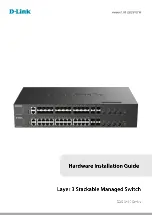
DGS-3312SR Stackable Gigabit Layer 3 Switch
22
3. Determine which network resources must be shared by the subnets. Shared resources may be connected directly
to Layer 3 Switches. Static routes to each of the shared resources should be determined.
4. Determine how each subnet will communicate with the WAN or Internet. Again, static routes should be
determined and default gateways identified.
5. Develop a security scheme. Some subnets on the network need more security or should be isolated from the other
subnets. IP or MAC filtering can be used. Also, one or more VLANs on the Layer 3 Switch can be configured
without an IP subnet – in which case, these VLANs will function as a layer 2 VLAN and would require an
external router to connect to the rest of the network.
6. Develop a policy scheme. Some subnets will have a greater need for multicasting bandwidth, for example. A
policy is a mechanism to alter the normal packet forwarding in a network device, and can be used to intelligently
allocate bandwidth to time-critical applications such as the integration of voice, video, and data on the network.
7. Develop a redundancy scheme. Planning redundant links and routes to network critical resources can save
valuable time in case of a link or device failure. The DGS-3312SR Spanning Tree function can be used to block
the redundant link until it is needed.
VLAN Setup
VLANs setup in Layer 3 Switching is more complicated than in conventional Layer 2 Switching environments. Be sure to
carefully plan the VLAN/IP interface arrangement for the network before configuring the VLANs and IP interface
associations.
VLANs configuration and concepts are provided in Part III.
Defining Static Routes
Routes between the IP interfaces and a default gateway or other router with a WAN connection should be determined
beforehand and entered into the static/default routing table on the DGS-3312SR.
Configuration of static routes and other uses of routing protocols are presented in Section IV.
















































